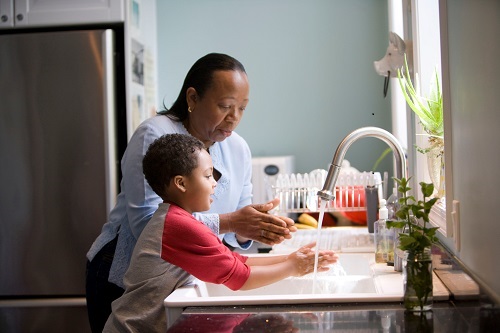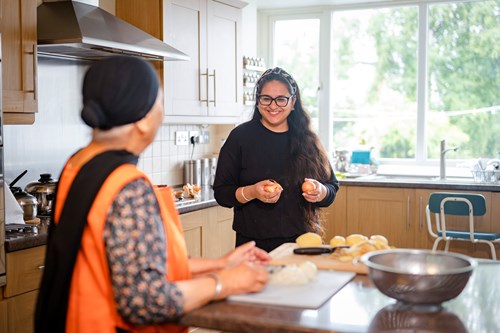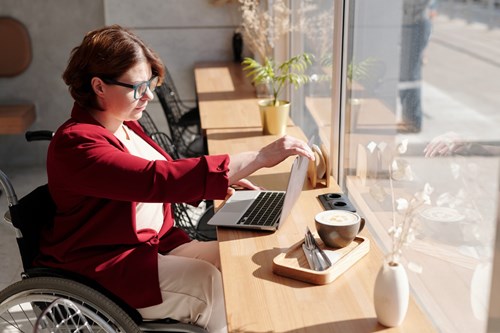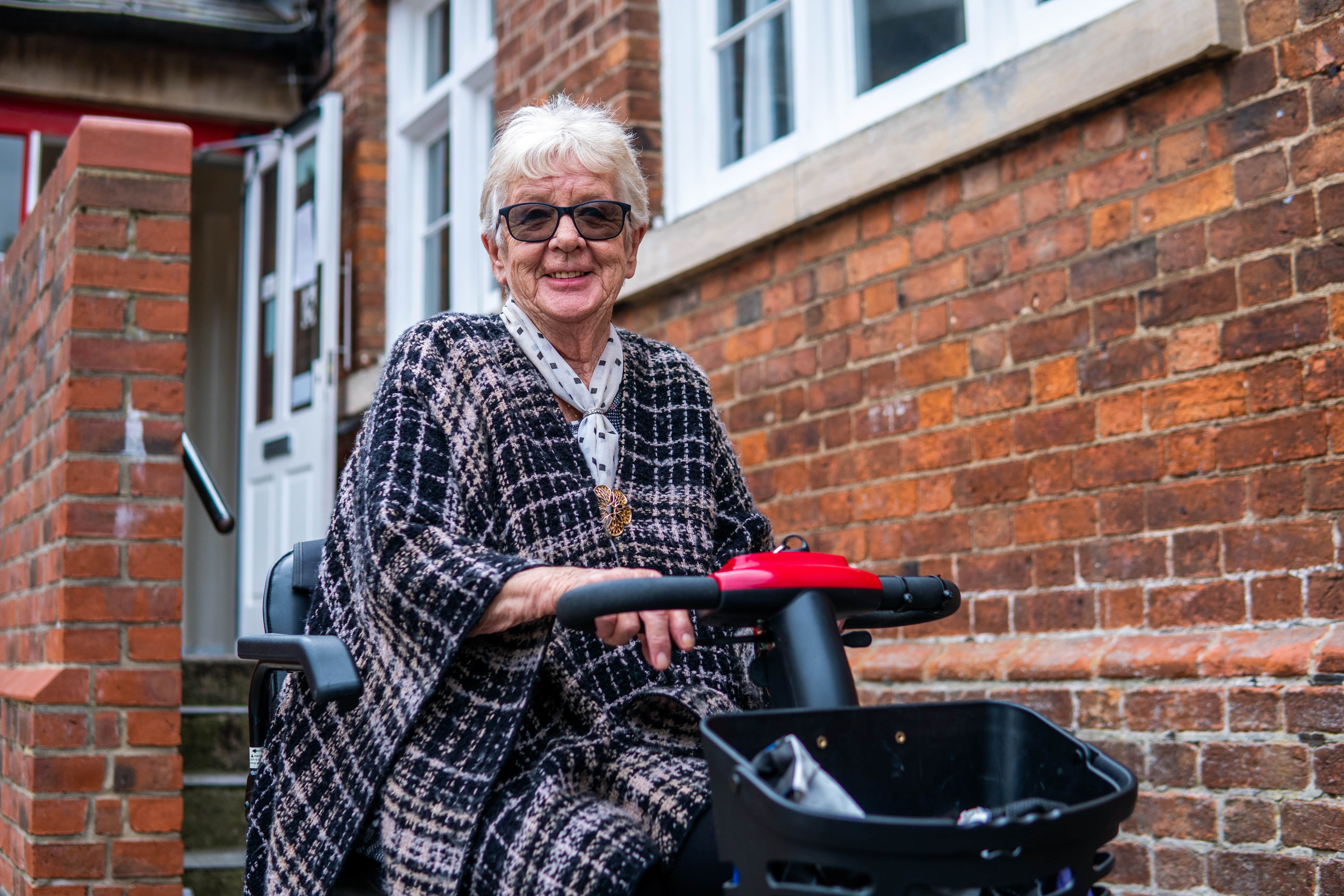Equipment, aids and home adaptations
Different types of equipment or changes to your home (or the home of the person you care for) could help make the home environment safer and life easier by providing independence for the person you are looking after, and peace of mind for you.
Below, we've prepared a list of ideas, room by room, including items of equipment (such as a raised toilet seat), smaller adaptations (such as fitting grab rails), and larger adaptations (such as installing a wet room).
Find out more about how getting a Disabled Facilities Grant might help with funding adaptations in the home in our Grants and schemes section.

Equipment for the home
If someone has difficulty turning taps on or you worry taps will be left on
It may be possible to install single lever taps which control both temperature and flow rate.
Some of these taps are also thermostatically controlled for increased safety. You can also get taps which turn on automatically when you put your hands under them so these could be an option too.
Alternatively, tap turners can be purchased to assist the person you are looking after to operate your existing conventional taps. The advantage of these is that they can be used if you are away from home.

If the person you’re caring for cannot stand up for long periods
Some tasks can be carried out whilst seated. For tasks like washing up or ironing, a perching stool may be useful.
You could also consider lowering the kitchen worktops especially if the person you care for uses a wheelchair or has difficulties reaching the worktop and using cupboards.
Try to store utensils at hip and eye level for the user or within their easy reach (unless this is considered unsafe). Some people find trays, adjustable knobs or movable kitchen trollies helpful.
If struggling with food preparation and cooking
Here are some ideas to consider for making these tasks easier and safe for someone with a disability:
- Use a kettle with a holder to make it easy to pour.
- Use non-slip mats on the worktop to stop things from sliding around.
- Use lightweight pots and pans which are easier to lift,
- Consider knives and forks with special handles to make them easier to hold, cups with two handles and easy to grip jugs, peelers or graters.
- Plastic measuring jugs may be lighter and easier to use than glass equivalents.
For more ideas, see our page 'Where to find products and services to help'.
If someone has difficulty getting in and out of the bath
Getting in and out of the bath can be extremely daunting for those who have limited movement or muscle weakness. Options to try to help could be a bath lift, a bath stool, a bath board, easy access bath tubs or a hoist fitted inside of the bath. You could also consider installing a wet room or walk-in shower.
Some people find that having grab rails attached to the wall or the side of the bath is really beneficial in offering support to get in and out of the bath.
If someone can't stand in the shower for long
You could consider a shower bench so that they can shower sitting down. To make it safer for the person you care for to take a bath or shower, use a rubber bathmat. Something as simple as a removable shower head or specially designed brushes can also be much easier to use if someone's movement is restricted.
Making it easier to use the toilet
To help the person you care for get on and off the toilet more comfortably, you could get a raised toilet seat. This would fit over your existing one. Adjustable toilet frames can also be fitted around the pedestal to offer more support.
Grab rails at the side of the toilet can also be helpful. Other options to explore could be a toilet seat with built in arm rests or a static or mobile commode.
If someone has difficulty getting in and out of bed
Getting in and out of bed is very frustrating and difficult if you are unable to move easily.
If you are caring for someone who finds this difficult, they might find leg lifters (straps to support you to lift your leg) helpful. Using glide sheets could also be helpful.
Bed raisers can increase the height of a bed and make it easier to get in and out of bed. They can be added under the legs or castors of beds. Or it may be preferable to have an adjustable bed with over-bed tables.
Are they worried about falling out of bed?
The possibility of unexpectedly falling from a bed is understandably frightening. If the person you are caring for is at risk of falling out of bed, you could look at the option of bed rails for safety. These can sometimes be removed during the daytime so that there is flexibility.
Being comfortable
Bed assists, leg supports and specially designed pillows can all be used to help improve someone's comfort levels in bed.
Is getting dressed and undressed difficult?
Someone who has a disability or who has restricted mobility might be keen to get dressed or undressed unassisted if this is possible.
There are devices that can help such as specially designed hooks that can help pull zips, undo buttons and put jackets on.
There are also many clever gadgets and gizmos that can help a person put socks, tights and underwear on.
Difficulties with continence?
There are a number of continence aids that can help such as portable bed pans and urinals, special bed or chair pads and supportive underwear. See our Continence care page for further support and guidance.
Other useful items such as a bed hoists allow people to pull themselves up to a sitting position or bed armchairs that can help people sit more comfortably.
Help with reaching items
A simple device called a reacher could potentially make a range of everyday tasks easier for disabled people – such as picking things up off the floor or from high up on a shelf.
Getting up and down and resting comfortably
Often a higher seated chair or a chair with arms is easier to get up from than a sofa. If the arms do not have any gaps at the side, this makes pushing up from them easier and means that nothing can slip through them and on to the floor.
Chair raisers or riser recliner chairs can be used if the person you care for struggles to get in and out of their current chair. Try not to use cushions to raise the height of the seat as this can be bad for the back.
Footstools can offer extra support and make sitting down easier especially if someone has leg pain or aches. Perching stools are also useful if they find it difficult to stand for long.
Getting around
If there are any steps into the home (or uneven flooring or steps within the home), a handle on the door frame could help, or an extra half step could be added to reduce the height. Fitting a ramp could also help reduce any related danger or offer easier access for wheelchair users.
If it is a lot of effort for the person you care for to answer the door, or if they can’t do it at all, you might want to consider installing a doorbell system that enables them to speak (and possibly see) the person at the door and let them in remotely.
Additionally, you could think about having doorways widened if you're helping someone who is a wheelchair user.
A second banister on the stairs could help the person you look after balance when they are going up and down, or you might wish to consider the installation of a stairlift.
Hand grips can make door handles easier to turn and magnifiers and bright lights can help people with vision loss.
Non-slip mats and stops can help rugs stay in place, or slippers with extra grip can prevent the risk of someone slipping or falling.

More information
We have more information about searching for useful aids and equipment on our 'Where to find products and services to help' page.
Adaptations for the home
It might be necessary to make long-term changes to the home to make things easier for someone who is living with a disability. Common examples are installing a grab rail in the bathroom, a stairlift, creating a walk-in shower or bathroom at ground level or widening doorways for better wheelchair access.
Help with costs
You can contact social services at your local authority for a home assessment. Or if you live in Northern Ireland, you would need to contact your local Health and Social Care Trust. Having one is free but you may have to wait for one. The assessment will be likely to be carried out by an occupational therapist who will review the home and make recommendations for changes to help. Another option is to enquire about any grants they have available for making home adaptations.
You could also discuss the requirements during a needs assessment for the person you look after. Usually an occupational therapist will help make recommendations as part of a home assessment. See our video below for more ideas.
In England, the local council should pay for adaptations that cost less than £1,000. In Scotland, Wales and Northern Ireland, the amount of funding and eligibility criteria differ. See the following links:
- Scotland: Note, you may be entitled to free personal care.
- Wales
- Northern Ireland
Disabled Facilities Grants
The occupational therapist may recommend a Disabled Facilities Grant which is a local authority grant to help towards the cost of adapting your home (or the home of the person you look after) to enable the person you look after to continue to live there.
A grant is paid when the council considers that changes are necessary and appropriate to meet their needs, and that the work is reasonable and practicable. In Scotland, a similar scheme is in operation but is not called a Disabled Facilities Grant. However, for ease of reference, we have retained the term.
A Disabled Facilities Grant can be used for a variety of uses to meet the needs of the person you are looking after including:
- access to the property from outdoors and access to a garden
- access inside the property such as widening doorways for a wheelchair or installing a stairlift
- installing better washing facilities or adapted bathroom
- adaptations to a kitchen such as lowering work tops
- improving heating systems (not in Scotland).
Financial help will not usually be available for building an extension to your home. But it depends on the reason you need the extension and the arrangements in your local area. An exception would be if the extension was the only way to provide a ‘standard amenity’, such as a bathroom or kitchen.
How to apply
In the first instance, contact your local authority or your local Health and Social Care Trust in Northern Ireland. Disabled Facilities Grants are administered by your local housing department rather than social services. Contact the housing department to apply.
You must apply for a grant before you start any work as you won't normally get any grant if you start work before the council approves the application.
Once they have received an application, the housing department should consult with social services and normally arrange for an assessment by an occupational therapist. The occupational therapist will consider the needs of the disabled person and also whether or not the adaptations are reasonable or practical given the age and condition of the property. For more information about these grants, see our grants and schemes page and watch our Share and Learn video led by Carers UK advisers, Liz and Priya.
What should I do with specialist equipment when it's no longer needed?
Some equipment can be returned to the NHS or local authority if this is where you originally sourced it. You can look up your local authority to check here: https://www.gov.uk/find-local-council.
If you're based in Northern Ireland, you would need to contact your local Health and Social Care Trust for guidance on this instead.
The occupational therapist you have worked with may have suggestions. For equipment that the original providers may not be able to take, there will be small companies, local businesses or even charities, such as Wheels to Heal, that could take it for you. There are a number of charities that are able to recycle equipment.
Some people also find social media a good way to spread the word and pass on aids or equipment to friends or family members or they may use channels such as Facebook Marketplace to sell or give away items locally. There is some helpful guidance on Scope's website about recycling second-hand disability equipment.

Latest updates

Charity calls for action with half of Scotland’s unpaid carers cutting back on food and heating amidst deteriorating health

Scotland’s National Carer Organisations launch election manifesto

Full Time Caring: A Journey in Mastering Mindfulness - Part 3

Carers UK marks 60 years of the carers’ movement and women’s leadership at Mary Webster Lecture
Got a question about caring?
Every day we hear from people who need help with looking after a friend or family member
Become a member for free
Joining Carers UK is free and takes just a few minutes.
